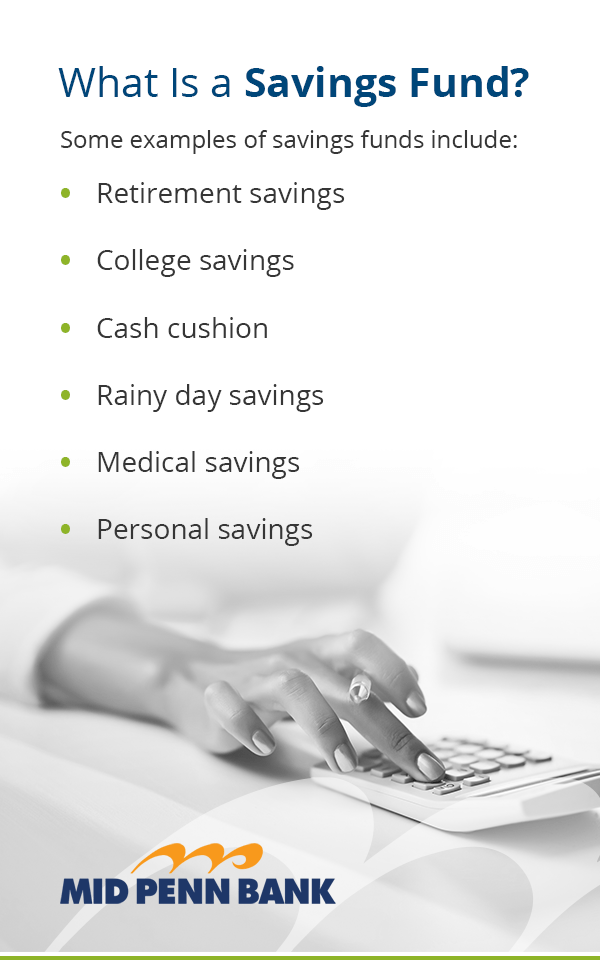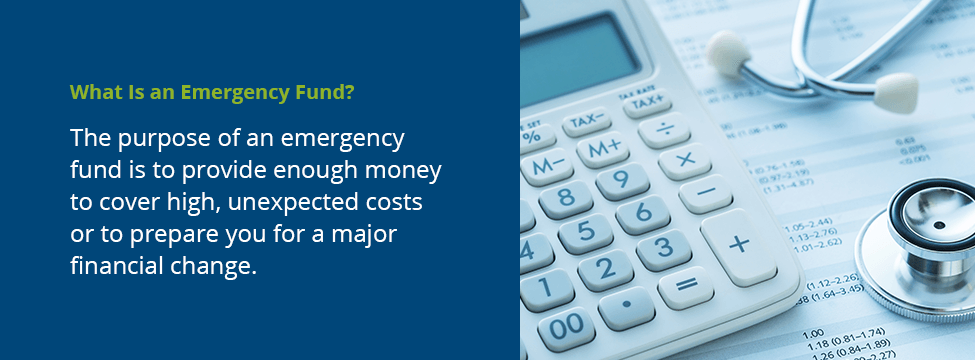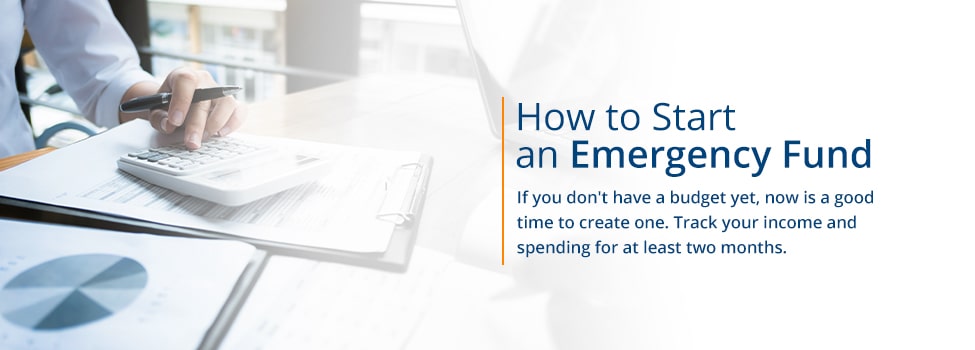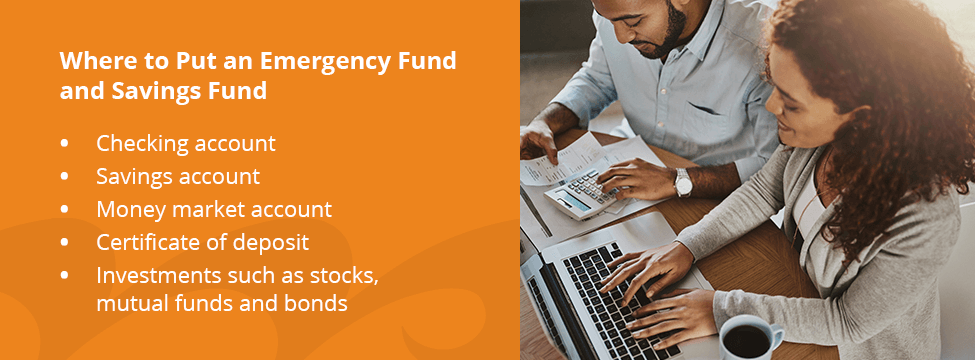The Difference Between Emergency and Savings Funds

Jump ahead:
What Is a Savings Fund?
What Is an Emergency Fund?
How Is an Emergency Fund Similar to a Savings Fund?
How Much Should You Save in an Emergency Fund?
How to Start an Emergency Fund
Emergency Fund vs. Savings: How Should You Use Them?
Where to Put an Emergency Fund and Savings Fund
How to Start Your Own Savings and Emergency Funds
If you were to have a sudden, unexpected expense, such as a medical bill or furnace repair bill, how would you pay for it? In the U.S., 64% of people say they could afford to pay for a $400 surprise expense using the equivalent of cash. Having some money set aside helps you handle unexpected bills or major financial changes in your life, such as job loss or a drop in income.
When it comes to methods of saving, you have a few options. You can create an emergency fund, build up a cash cushion and open savings funds for other life goals, such as retirement or a down payment on a home. Take a closer look at the difference between an emergency fund and other types of savings funds and learn how to start saving money to protect yourself from life’s surprises.

What Is a Savings Fund?
A savings fund is an account where you set aside money for a particular goal. The goal can be short-term, such as saving up enough to cover the cost of a down payment on a house or to purchase a new car. It can also be long-term, such as saving for retirement or for your children’s college education. You can have a savings fund that you use to cover unexpected expenses, such as the cost of a car repair or a new refrigerator after yours breaks. You can have as many or as few savings funds as you need based on your life situation.
Some examples of savings funds include:
- Retirement savings: Whether you have a 401(k) through your employer, an IRA or a combination of the two, retirement savings let you set money aside for your future. Many retirement savings funds have tax advantages, such as letting you contribute to the account with before-tax income. The trade-off is that you need to leave the money in the account until you reach retirement age, or you risk paying the penalty on early withdrawals.
- College savings: College savings accounts let you set money aside for your children’s post-secondary education. You can choose to save in an account, such as a 529 plan specifically designed to save for college. A 529 plan offers tax advantages, and it needs to be used to pay for education or related expenses.
- Cash cushion: A cash cushion is a type of savings fund that offers you protection against overdrafts. It’s an amount of money in your checking account that keeps you from overdrawing the account. Your cash cushion can be anywhere from $100 to $1,000. If you regularly balance your checkbook and keep track of deposits and withdrawals to your account, you can safely have a smaller cushion. If you don’t pay close attention to your checking account, a bigger cushion can save you the costs of overdrawing or bouncing a check.
- Rainy day savings: A rainy day savings fund can cover the unexpected costs of life, such as having to repair an appliance, pay for a school trip or cover the cost of your pet’s vet bill. Your rainy day fund doesn’t have to be very large. Anywhere from a few hundred to a thousand dollars can be sufficient.
- Medical savings: While health insurance may pay for many of your medical expenses, it might not cover everything. You might also have an annual deductible you are responsible for before coverage begins. Medical savings can cover the cost of prescriptions, office visits and other health-care-related expenses. Depending on the type of insurance coverage you have, you can open a Health Savings Account (HSA), which allows tax-deductible contributions. If your expenses are high enough and you don’t have an HSA, you could potentially deduct them when you file your tax return.
- Personal savings: A personal savings fund lets you save for whatever you want, from a house to a vacation.

What Is an Emergency Fund?
Like a retirement fund or college savings fund, an emergency fund is a type of savings fund. The purpose of an emergency fund is to provide enough money to cover high, unexpected costs or to prepare you for a major financial change. An emergency fund’s goal is to keep you from having to borrow money or max out your credit cards if life becomes financially challenging.
One of the most significant life changes an emergency savings fund protects against is a job loss or a dramatic reduction in income. The money you’ve saved in an emergency fund can support you as you look for new work or as you look for additional sources of income.
Like a rainy day fund on a bigger scale, an emergency savings account can also provide funds when you have a major unexpected expense. If your home’s HVAC system breaks and needs replacement, you might use your emergency fund to cover the expense. If your pet needs surgery and you don’t have pet insurance, you may need to use money in your emergency fund to cover the cost.
Try to only use emergency fund money when you absolutely need it. Medical and personal savings or rainy day funds can help cover uncommon expenses before you use money from an emergency fund.
How Is an Emergency Fund Similar to a Savings Fund?
An emergency fund is a type of savings fund. When you create an account for emergencies, you’re saving money. It’s not so much comparing a savings account versus an emergency fund as it is establishing an emergency fund that gives you a way to save money.
That said, it’s often ideal to focus on setting money aside in an emergency account before you start to focus on other financial goals. Once you’ve built up your emergency savings, you’ll have a cushion available should you lose an income source or have a surprise expense.
How Much Should You Save in an Emergency Fund?
The exact amount you’ll need in an emergency fund depends on your life situation and income. The standard recommendation is to have between three and six months’ worth of expenses set aside. Your emergency fund can be smaller if you have multiple income sources, like if both you and your partner earn money. If only one person earns income, you might want to focus on having a bigger amount saved for emergencies.
Another thing to consider when building up your emergency fund is the cushions available to you if you lose a job or have a significant expense. If you lost work, could you get unemployment? If you have a medical issue, will insurance cover all or some of the cost?
Part of figuring out how much to save for emergencies involves knowing how much you spend each month. Tracking your expenses and creating a budget can give you a realistic idea of what you spend each month. It can also be worthwhile to create an emergency budget or barebones budget that includes all the expenses you need to pay each month, such as rent or mortgage, a car bill, health insurance and food.
Once you have that figure, multiply it by three or six to get your emergency savings goal.

How to Start an Emergency Fund
Choosing a goal figure is the first step when starting an emergency fund. Once you decide on a goal, the next thing to do is figure out how much to save each month and how you’ll afford to save for an emergency.
If you don’t have a budget yet, now is a good time to create one. Track your income and spending for at least two months. Then, examine your expenses and spending closely to see if you have funds available to set aside. You might need to adjust your spending, such as by cutting back on things you don’t need or by finding less expensive alternatives.
Pick an amount to set aside every month based on what you can afford. Calculate how long it will take to reach your goal based on what you can afford to save. If you have $150 to spare every month and you want to save $5,000, it will take you just under three years to achieve your goal.
It can help to break up your goal into smaller amounts to give yourself a sense of accomplishment and to encourage you to keep on. Instead of working to save $5,000 at once, start by trying to save $1,000. Setting aside $150 monthly, you’ll save $1,000 within seven months. Once you reach that $1,000 goal, increase it and keep saving.
Emergency Fund vs. Savings: How Should You Use Them?
Savings funds and an emergency savings account can give you a sense of purpose for your finances. If you don’t have a plan or goal for your money, it can be easy to overspend. Some of the uses for savings funds include:
- To avoid debt: A full emergency fund can keep you out of debt and help you avoid ongoing financial hardship. There is uncertainty in life, and you can’t predict how long it will take to find a new job or when breakdowns or illness will happen. Having enough money set aside “just in case” means you can avoid taking out a loan with a high interest rate or avoid maxing out your credit cards.
- To save for the future: Savings funds help you make plans for the future, whether those plans are for yourself after retirement or for your children. Often, the earlier you start saving for the future, the better, as your money will have more time to grow in investments or savings accounts.
- To reach your financial goals: Think about your goals in life. Whether you want to buy a house, travel around the world or earn an advanced degree without going into debt, having savings or making a plan to save can help you achieve your goals.

Where to Put an Emergency Fund and Savings Fund
Where you put your emergency fund and other savings funds depends largely on the fund’s goal and how easily you’ll need access to the money. Some options include:
- Checking account
- Savings account
- Money market account
- Certificate of deposit
- Investments such as stocks, mutual funds and bonds
Liquidity refers to how easy it is to get your money when needed. Some funds can be less liquid than others. Checking and savings accounts are very liquid, while investment accounts are less liquid. Your retirement funds can be relatively illiquid while you are saving up, so it can be in the form of bonds, stocks or mutual funds. You might also open up certificates of deposit (CD) for retirement savings.
It makes sense to keep a cash cushion in your checking account, so there is padding around your money in case you go over budget one month or bill payment occurs before your next paycheck arrives.
Though you only want to access the money in an emergency fund during an emergency, it should be fairly liquid, as you might need the funds at any time. A savings account or money market account can be an ideal location for your emergency fund. The money in the account will earn interest, but you’ll still be able to withdraw it when you need it.
Another option is to create a CD ladder for your emergency fund. When you open a CD, you agree to leave the money in the account for a set term, such as 12 months. If you need to withdraw the money before the term is over, you pay an early withdrawal penalty, usually worth a few months’ interest.
With a CD ladder, you open a 12-month CD with a portion of your emergency fund, such as one month of expenses. The next month, you open a second 12-month CD. Since you’ve opened the CDs at different times, they will mature one month apart from the other. If you need to get access to your emergency fund, you can take the money out of the CD at the end of the term, or you can let it renew.
How to Start Your Own Savings and Emergency Funds
If you are starting to save, you can begin small. You don’t have to make saving three or six months of expenses your goal right away. Instead, start by aiming to save $500 or $1,000 for an emergency. Create a budget and determine how much you can comfortably afford to save each month.
If you can save $200 per month, you’ll reach your $1,000 goal after five months. Once you reach that initial goal, make a new one, such as saving a full month worth of expenses in your emergency fund. Every time you reach your savings goal, increase it until you have your full target amount in your emergency fund.
As you begin saving, it helps to prioritize your goals. You may save for an emergency first, focus on debt repayment or start saving for retirement. Your priority depends on your financial situation. If you have significant or high-interest debt, paying it off first can be ideal. Once you pay off your debt, use what you had been putting toward debt payment into your savings instead.
You could also pay off debt while also saving to act as a safety net in case anything unexpected happens. Even if you can only save $50 per month or less while you pay debt, you can start small and build your way up.
If you’re concerned that you’ll spend your money before you save it, you have some options:
- Set a budget: Understanding how much money you have compared to how much you spend can put in perspective what you could be saving if you cut back.
- Set up automatic transfers: Use automatic transfer features to have money go from a checking account to a savings account whenever you get paid. This eliminates the temptation of spending over your budget.
Mid Penn Bank Can Help You Establish an Emergency Fund or Other Savings Fund
Whether you want to build up an emergency fund to protect yourself in case of job loss or hope to start saving for retirement, your child’s education or another major life goal, Mid Penn Bank can help. We’re happy to answer any questions you have about saving money, making a budget or choosing the account that will work for you. Contact us today to learn more.
Share:
Disclosures
The material on this site was created for educational purposes. It is not intended to be and should not be treated as legal, tax, investment, accounting, or other professional advice.
Securities and Insurance Products:
NOT A DEPOSIT | NOT FDIC INSURED | NOT BANK GUARANTEED | NOT INSURED BY ANY FEDERAL GOVERNMENT AGENCY | MAY LOSE VALUE

